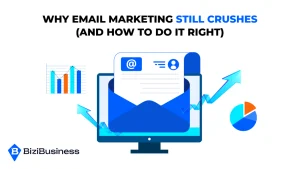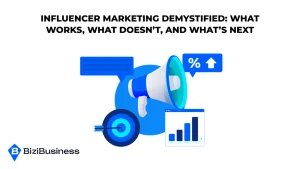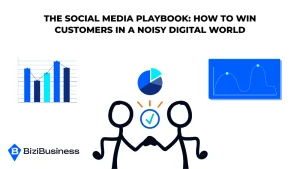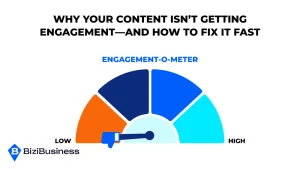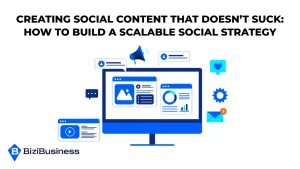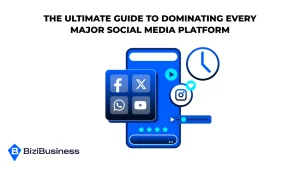BiziTopics
The Ultimate Guide to Choosing the Right Social Media Tools for Your Brand
BiziBusiness
Aug 12, 2025
13 min read
Social media is noisy, fast-paced, and constantly changing. Without the right tools, it’s nearly impossible to stay consistent, engage your audience, or measure results.
The brands winning today aren’t just posting more—they’re using smart tools to streamline content, track performance, and scale fast.
Think of social tools as your growth engine. They help you:
- Post on time, every time
- Keep brand visuals and voice aligned
- Monitor engagement and trends
- Integrate with SEO and lead gen efforts
In short: better tools mean better marketing. This guide will help you cut through the clutter and choose the tools that actually move your business forward.
Core Categories of Social Media Tools
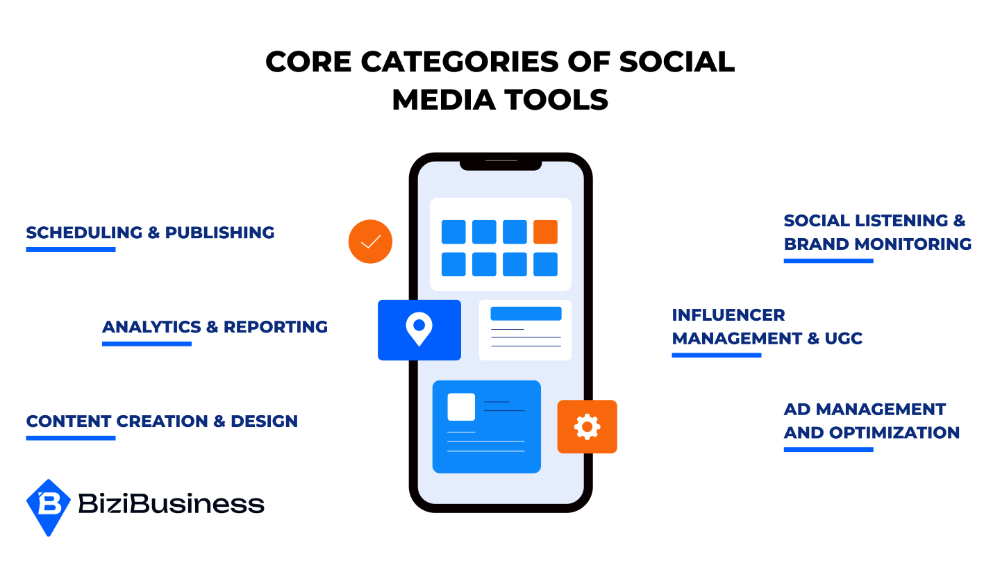
The social media landscape is vast, but most tools fall into specific functional buckets. Understanding these categories helps you identify what your brand actually needs—and avoid tool overload. Below is a breakdown of the most important types of tools and what each brings to your marketing stack.
Scheduling & Publishing
These tools automate the repetitive task of manually posting across different platforms. They allow you to:
- Schedule content in advance for consistent posting
- Plan multi-platform campaigns in one dashboard
- Preview how content will look on each platform
- Maintain a balanced content mix through calendar views
Why it matters: Consistency boosts reach and engagement. Without scheduling, brands often go silent or post reactively—hurting performance.
Popular tools: Buffer, Later, Loomly, Planoly
Analytics & Reporting
Data-driven marketing wins. These tools offer detailed metrics like:
- Follower growth, reach, impressions, engagement rates
- Link clicks, conversions, and post-level performance
- ROI tracking for organic and paid content
- Customizable dashboards and automated reports
Why it matters: You can’t optimize what you don’t measure. These tools help you double down on what’s working—and cut what’s not.
Popular tools: Sprout Social, Agorapulse, Metricool, Socialinsider
Engagement & Community Management
Community-building is more than posting—it’s responding, supporting, and connecting. These tools help you:
- Manage comments, DMs, reviews, and mentions in one place
- Assign responses to team members for faster support
- Tag conversations by sentiment or urgency
- Track response time and customer satisfaction metrics
Why it matters: Active engagement builds trust and brand loyalty. It also signals to algorithms that your account is relevant and active.
Popular tools: Hootsuite Inbox, Sprinklr, SocialBee, Zoho Social
Content Creation & Design
These tools are ideal for non-designers who need to produce professional-quality visuals or videos quickly. Features often include:
- Drag-and-drop templates
- Brand kits for fonts, logos, and colors
- Social-specific dimensions and layouts
- Video trimming, captions, transitions, and animations
Why it matters: Visuals catch attention. If your brand lacks a full creative team, these tools are essential for standing out in a crowded feed.
Popular tools: Canva, Adobe Express, Kapwing, Visme
Social Listening & Brand Monitoring
These go beyond vanity metrics and into deeper insights:
- Track brand mentions across platforms—even without tags
- Monitor competitor activity and keyword trends
- Identify emerging industry topics and customer sentiment
- Get alerts on potential PR issues or brand threats
Why it matters: Listening tools keep you ahead of trends, prevent crises, and help you understand your audience in real time.
Popular tools: Brandwatch, Mention, Talkwalker, Meltwater
Influencer Management & UGC (User-Generated Content)
These tools streamline influencer collaboration and make it easier to track campaign results. Core features include:
- Influencer discovery and outreach tools
- Campaign tracking with performance metrics
- UGC rights management and content curation
- ROI measurement and audience quality checks
Why it matters: Influencer partnerships can drive massive reach—but only if managed properly. These tools reduce manual tracking and risk.
Popular tools: Upfluence, CreatorIQ, Aspire, GRIN
Ad Management & Optimization
These tools help you get more from your ad budget by:
- Managing campaigns across Facebook, Instagram, LinkedIn, TikTok, and Google from one dashboard
- Running A/B tests to improve creative and targeting
- Automating bid adjustments based on performance
- Forecasting ROI and cost-per-acquisition
Why it matters: Paid social is competitive and expensive. These tools ensure your budget goes further and your ads convert.
Popular tools: AdEspresso, Revealbot, Smartly.io, Madgicx
How to Choose: Match Tools With Brand Goals

Before you start testing platforms or comparing pricing plans, get clear on this: what’s the outcome you actually want? Because not every tool is built for every goal—and stacking the wrong ones just burns budget without delivering results.
Start With the End Goal
Ask: What’s the #1 thing I need social media to do for my business right now?
- Need to build awareness? Focus on scheduling, content creation, and social listening tools.
- Want to boost engagement? Prioritize community management and design platforms that keep your brand visually consistent and interactive.
- Looking for conversions? Lean into analytics, ad optimization, and tools that integrate tightly with your funnel.
- Trying to improve retention and loyalty? Community tools and influencer/UGC platforms will help you stay connected.
Choose Tools That Match Your Growth Stage
Not every business needs an all-in-one suite—especially in the early stages. Here’s a quick breakdown:
- Solo or small business: Focus on lightweight, all-in-one platforms that combine scheduling, analytics, and basic design.
- Scaling brand or agency: Add depth—layer in listening, influencer tools, and robust analytics.
- Enterprise: Invest in modular platforms that integrate deeply across your marketing and CRM stack.
The BiziBusiness Mindset: ROI Over Noise
This is where many teams get stuck—chasing tools packed with features they’ll never use. At BIziBusiness, we’ve seen it time and time again: the most effective stacks are lean, not loaded.
Avoid shiny object syndrome. Skip the fluff. Choose tools that:
- Save time
- Drive data-backed decisions
- Directly support SEO, content, or lead-gen efforts
Because when every tool aligns with revenue and reach, you don’t just do social—you grow with it.
Top Recommended Tools by Function
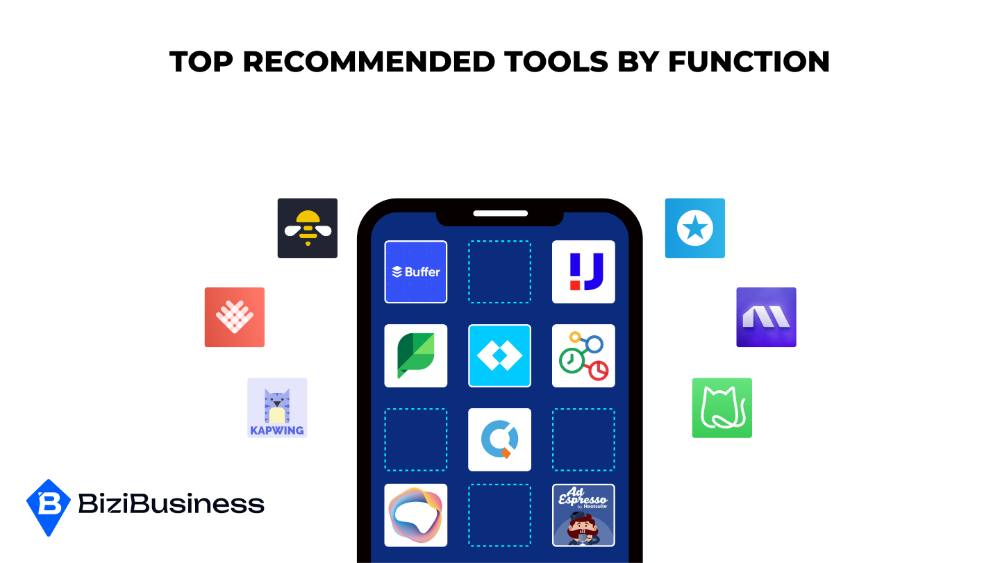
You know what your goals are. Now let’s match them with the right tools—based on what they actually do, how they perform, and which brands they’re best suited for.
This isn’t a fluff list. These tools are battle-tested by teams focused on growth, not gimmicks.
Scheduling & Publishing
| Tool | Best For | Notes |
|---|---|---|
| Buffer | Simple, clean scheduling | Great for small teams, very user-friendly |
| Later | Visual-first content planning | Ideal for Instagram and TikTok workflows |
| Loomly | Teams needing approval workflows | Built-in collaboration, calendar previews |
Analytics & Reporting
| Tool | Best For | Notes |
|---|---|---|
| Sprout Social | Deep analytics + CRM integrations | Pricey but powerful—great for scaling brands |
| Agorapulse | Balance of insights and affordability | Strong reporting, smart inbox included |
| Metricool | Multi-platform insights | Lightweight but strong data visualization |
Engagement & Community Management
| Tool | Best For | Notes |
|---|---|---|
| Hootsuite Inbox | High-volume customer support | Centralized messaging, team tagging |
| SocialBee | Budget-conscious engagement | Combines posting + audience interaction |
| Zoho Social | CRM-focused engagement | Best if already using Zoho ecosystem |
Content Creation & Design
| Tool | Best For | Notes |
|---|---|---|
| Canva | Non-designers + teams | Templates, brand kits, and animation |
| Adobe Express | Quick, pro-grade design | Ideal for repurposing across formats |
| Kapwing | Short-form video content | Great for reels, YouTube Shorts, and edits |
Social Listening & Monitoring
| Tool | Best For | Notes |
|---|---|---|
| Brandwatch | Deep enterprise-level listening | Market trends, sentiment, crisis alerts |
| Mention | Real-time alerts | Easy setup, good for brand monitoring |
| Talkwalker | Insight-heavy competitor tracking | Powerful dashboards, higher learning curve |
Influencer Management & UGC
| Tool | Best For | Notes |
|---|---|---|
| Upfluence | Full influencer lifecycle | From discovery to payment |
| CreatorIQ | Data-rich campaign tracking | Excellent for agencies and enterprise |
| Aspire | UGC + micro-influencer sourcing | Good for ecom and lifestyle brands |
Ad Management & Optimization
| Tool | Best For | Notes |
|---|---|---|
| AdEspresso | Facebook + Instagram split-testing | Ideal for rapid-fire ad experiments |
| Revealbot | Automated budget scaling | Real-time rules for scaling winners |
| Madgicx | Cross-platform optimization | Combines creative AI + performance data |
This isn’t about stacking every tool—it’s about building a lean, intentional system that scales with you. Use this as a launchpad, then refine as your strategy matures.
Pitfalls to Avoid When Selecting Social Media Tools
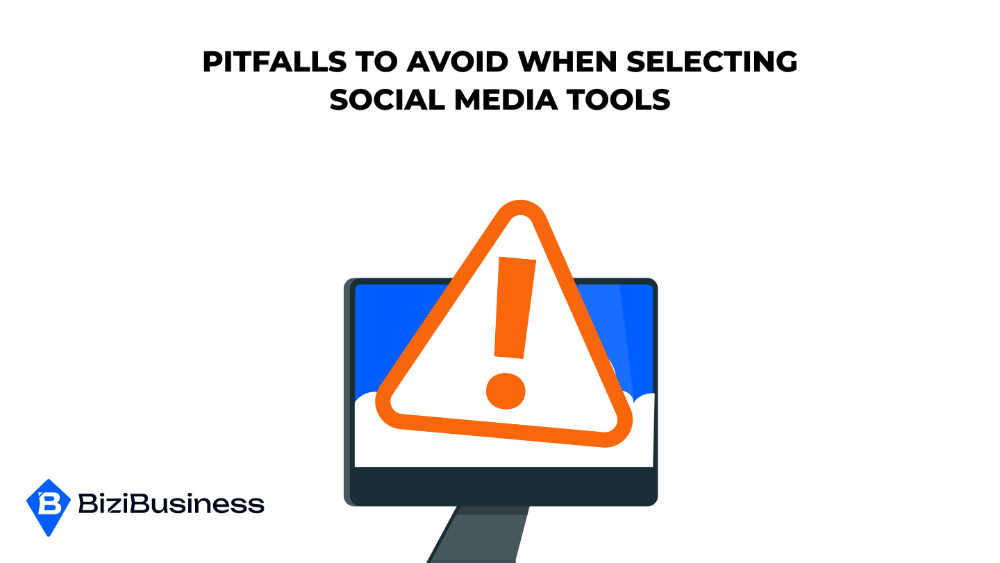
The right tools can fuel your growth. The wrong ones? They slow you down, bleed budget, and bury your team in busywork. Here are the most common mistakes brands make when building their social toolkit—and how to avoid them.
1. Buying Based on Hype, Not Need
Every year, new platforms launch with bold claims and shiny dashboards. But most of them aren’t built for your business. Many marketers jump in based on influencer marketing or peer pressure, without asking the most important question:
Does this tool directly support my current stage and strategy?
If the answer is no, it’s a distraction. Tools should solve a real problem, streamline a key workflow, or create a measurable improvement. If they don’t, you’re not scaling—you’re stacking.
2. Overcomplicating the Stack
A powerful stack doesn’t mean a crowded one. Teams often overload on tools that overlap or create fragmented workflows. The result?
- Repetitive tasks across platforms
- Logins and tabs everywhere
- A frustrated team unsure where to find what
Complexity kills consistency. If your stack takes more time to manage than it saves, it’s time to simplify. Choose tools that centralize workflows, not multiply them.
3. Ignoring Integration Capabilities
A tool that doesn’t play well with your CRM, email platform, or analytics suite adds friction. That means:
- Manual reporting
- Broken tracking
- Missed insights across campaigns
Integration is power. Whether you’re using HubSpot, Notion, ClickUp, or Google Workspace—your tools should fit into that ecosystem and automate the flow of information.
4. Mistaking Automation for Strategy
There’s automation, and then there’s autopilot—and not the good kind. Some tools promise faster growth through tactics like:
- Auto-following or bot replies
- Spammy DMs or keyword-stuffed comments
- Fake engagement loops
These violate platform guidelines and can lead to shadowbanning, account suspension, or long-term damage to brand trust.
As we say at BiziBusiness: Shortcuts often lead to setbacks. Automation is great when it enhances real engagement—not when it fakes it.
5. Not Measuring ROI or Business Impact
This is the silent killer. Teams use tools every day without ever asking:
- What are we actually getting from this?
- How much time is it saving?
- How does it move the needle on leads, revenue, or retention?
If your tools aren’t tied to performance, you’re guessing. Every platform should be justified by outcome—not just activity.
Look for real signals of ROI from your engagement strategies: more qualified traffic, faster response times, better-performing content, and higher conversion rates.
Integrating Social Tools With SEO & Lead Gen
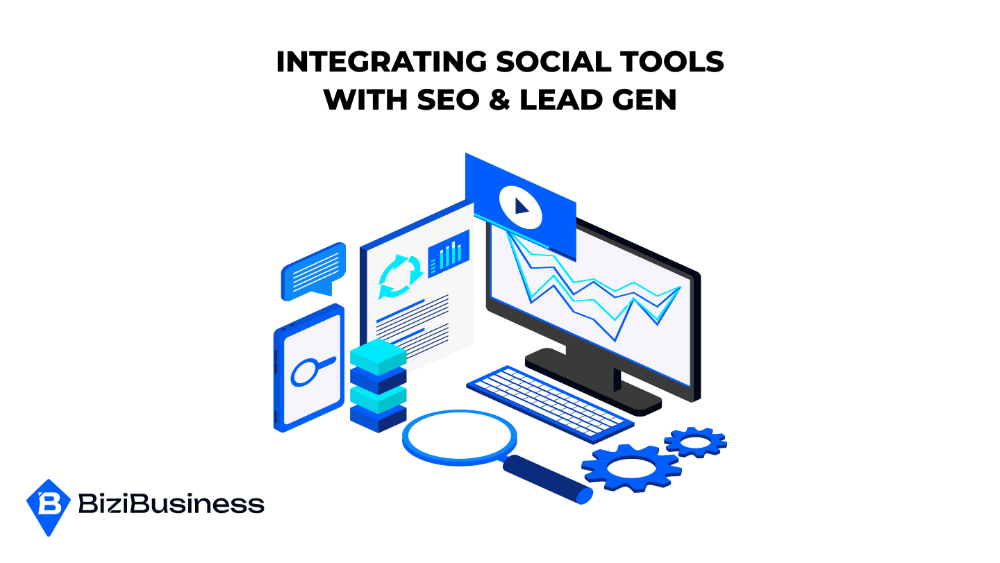
Most brands treat social and SEO like separate silos. But when you connect them strategically, you create a feedback loop that multiplies reach, engagement, and leads.
Social media tools don’t just help you post—they help you listen, adapt, and convert. Here’s how to use your stack to drive real business outcomes beyond likes and follows.
Turn Social Content Into Organic Fuel
Your content calendar is one of your biggest SEO assets—if you align it with what people are actually searching for.
- Use social listening tools (like Mention or Brandwatch) to spot emerging questions and trends
- Build content clusters that target those topics across blog, video, and social
- Use scheduling tools to repurpose SEO blog posts into short-form social content with backlinks
Why it matters: Every social post becomes a distribution channel for SEO-optimized content—building authority while engaging audiences in real time.
Use Analytics to Guide Keyword Strategy
Don’t just guess what content works—your analytics and metrics tools already have the answers:
- Use engagement data to find top-performing themes
- Use link tracking (via Sprout or Metricool) to see which posts drive site visits or signups
- Feed that insight back into your blog and landing page strategy
Smart move: Let your social data guide keyword research. If something performs well organically on social, it’s likely worth optimizing on your site too.
Bridge the Gap Between Engagement and Leads
Social engagement is great—but it’s not the end goal. Here’s how to connect your tools to your funnel:
- Use link-in-bio tools with UTM tracking to measure lead traffic
- Integrate social ads with retargeting audiences built from site visitors or email lists
- Pair your CRM (like HubSpot or Zoho) with your social tools to track lifecycle value from first touch to closed sale
Pro tip: Many platforms now offer native lead-gen forms—tools like Revealbot can help you optimize and scale these with rules-based automation.
The BiziBusiness Angle: Organic Growth Is Multi-Channel
As we teach at BiziBusiness, SEO isn’t just about Google—it’s about owning the customer journey across all channels. Social tools are a vital part of that strategy:
- They boost discoverability
- Create authority through consistency
- Drive high-ROI organic traffic
When your tools are aligned, your SEO strategy doesn’t just rank, it converts.
Future-Proofing Your Social Stack
Social media marketing doesn’t stand still—and neither should your tech stack. Platforms, algorithms, and user behaviors evolve rapidly. If your tools can’t keep up, your results will suffer. Future-proofing isn’t about constantly chasing trends—it’s about building a foundation that can adapt, scale, and stay effective as the landscape shifts.
Start by prioritizing tools that embrace AI and automation. Today’s leading platforms do more than schedule posts—they suggest the best times to publish, generate captions and hashtags, flag risky engagement, and even automate ad optimization. Tools like Sprout Social, Revealbot, and Canva are already leveraging AI to streamline and strengthen workflows. Choosing tools with these forward-looking capabilities now means fewer growing pains later.
Next, opt for platforms that move quickly and integrate easily. Speed isn’t just about content delivery—it’s about your ability to pivot. Tools that offer frequent updates, support API integrations, and connect with your CRM or CMS are essential for staying agile. Avoid platforms that feel closed, clunky, or outdated. If they aren’t improving, they’re holding you back.
But future-proofing isn’t just about software. It’s about strategy. A common mistake businesses make is building a stack around features—not outcomes. Every tool should reinforce your bigger goals: stronger content, smarter targeting, better lead gen. As BiziBusiness teaches, tools are only as good as the strategy behind them. They don’t fix a broken funnel—they just make it more expensive to run.
Finally, stay informed. Subscribe to product update emails, join marketing communities, and carve out time each quarter to review what’s working and what’s not. A “set-it-and-forget-it” approach may have worked in the past—but today, flexibility wins.
If you build your social stack with scalability, integration, and impact in mind, you’ll stay ahead of trends and competition. Your tools will evolve with you—not against you.
Choose Smart, Scale Fast
Choosing the right social media tools isn’t about collecting the trendiest logos on your tech stack—it’s about making smarter decisions that help your brand move faster, grow stronger, and operate more efficiently.
Every business has different needs. A solo entrepreneur shouldn’t use the same tools as a global marketing team. What matters is aligning your stack with your specific goals—whether that’s engagement, lead generation, conversions, or customer retention. The tools you choose should simplify your process, amplify your strategy, and deliver measurable outcomes.
And remember: more isn’t better. A lean, focused toolset—one that integrates well, embraces AI, and evolves with your strategy—will outperform a bloated system every time. What matters most is not what tools can do, but what they do for your business.
At BiziBusiness, we’ve helped brands of all sizes move past complexity and focus on what works. Because when you stop chasing tools and start choosing intentionally, that’s when your marketing starts to scale.
Now is the time to refine your stack. Audit what’s helping, cut what’s not, and build a toolkit designed for momentum—not maintenance. Choose smart, scale fast, and stay ahead.
Subscribe to Newsletter
Unlock your creativity and stay up to date on marketing tips
